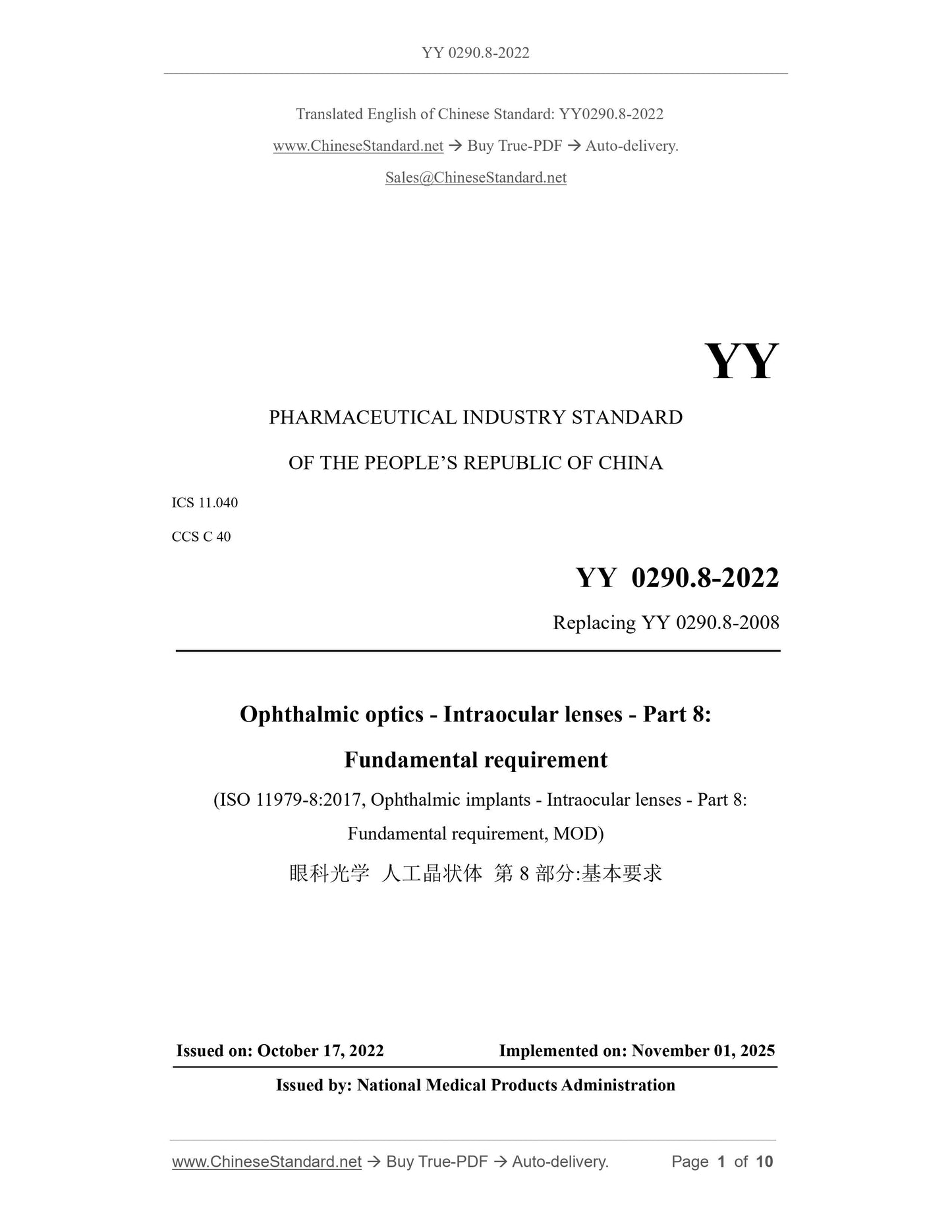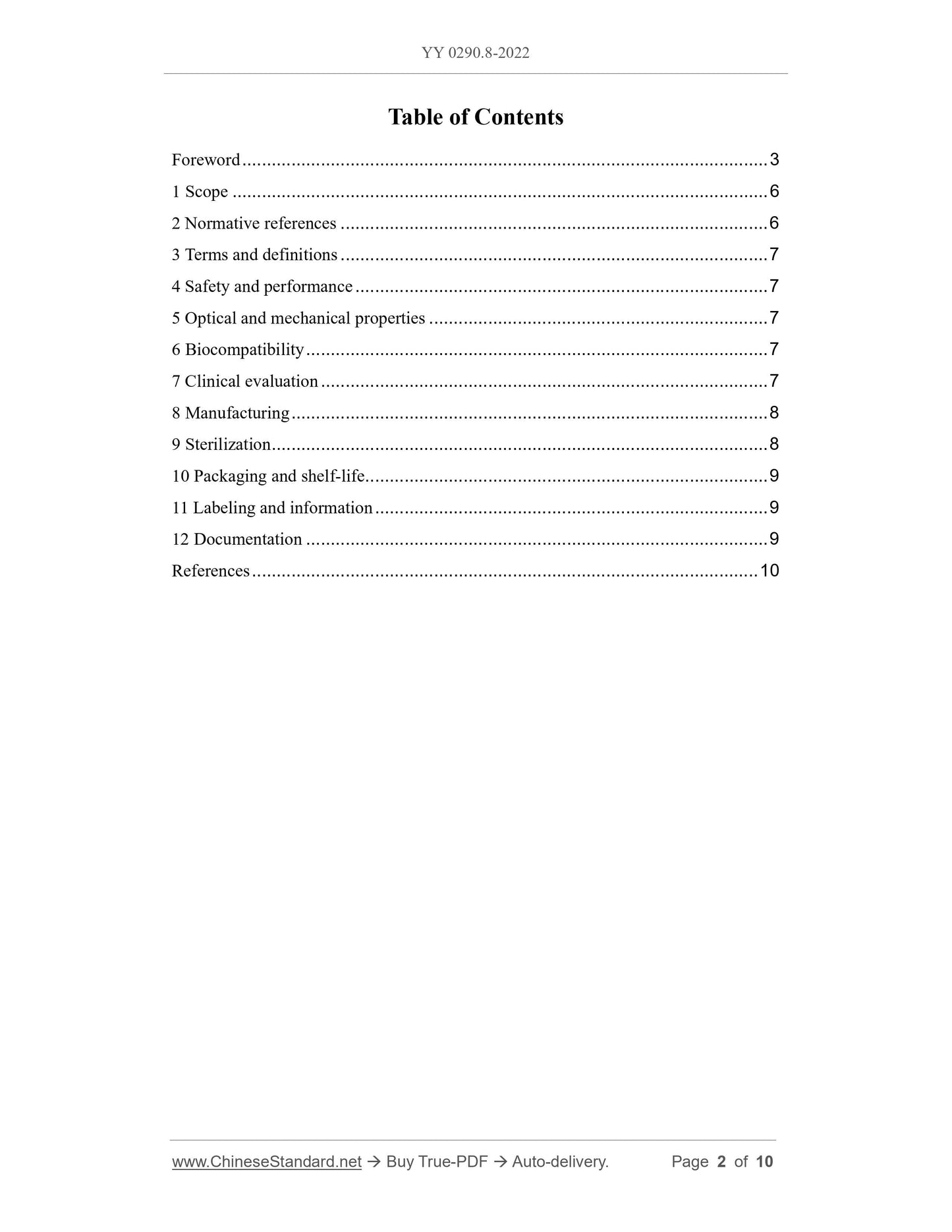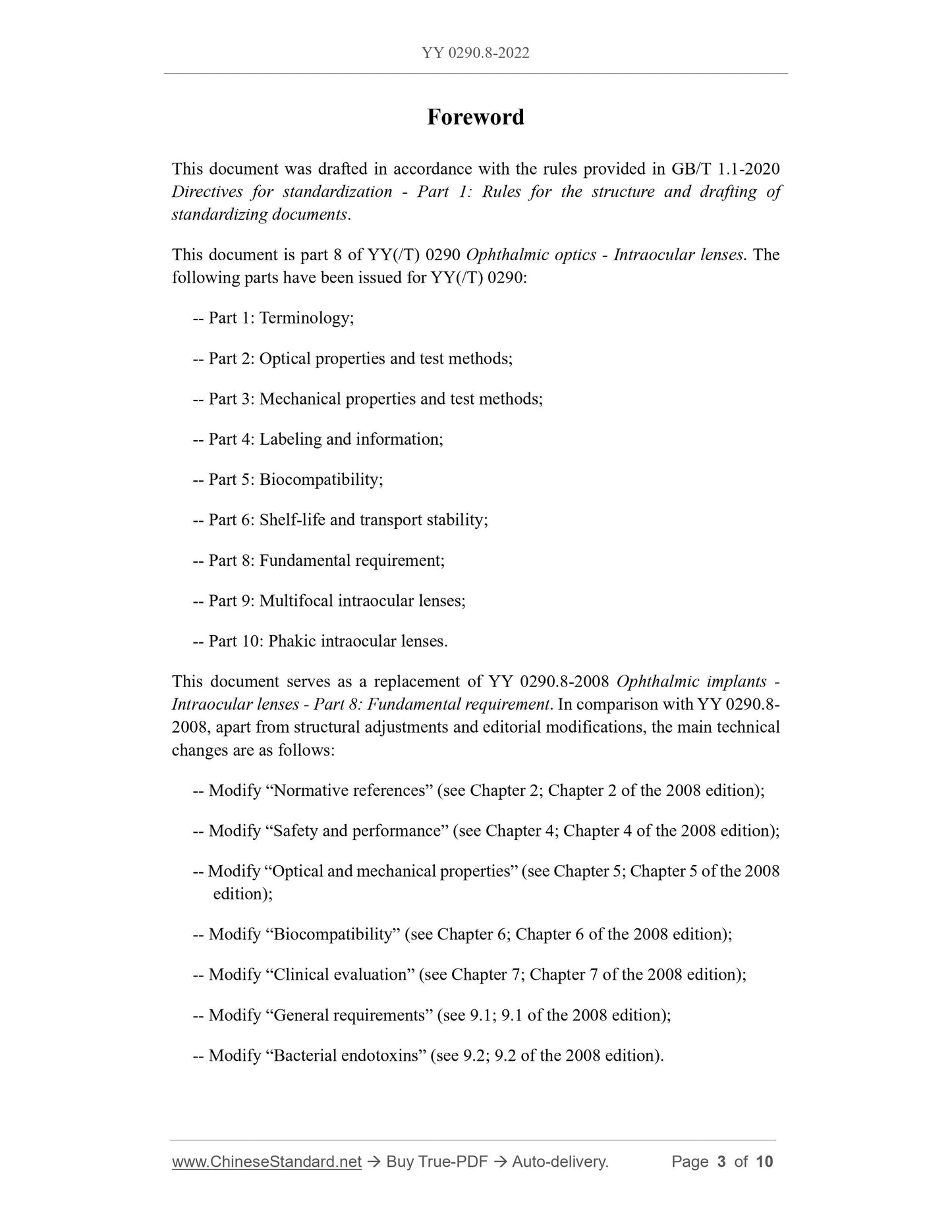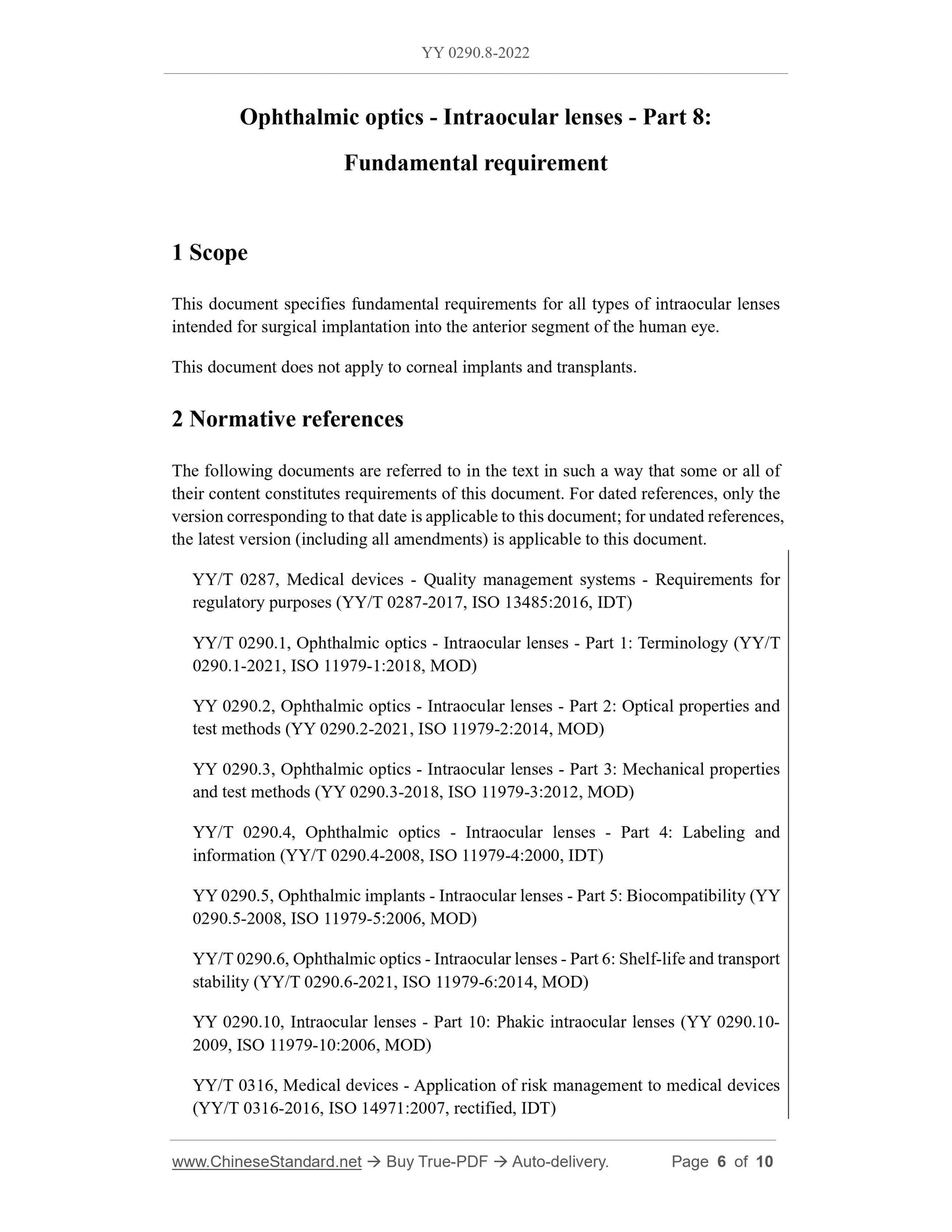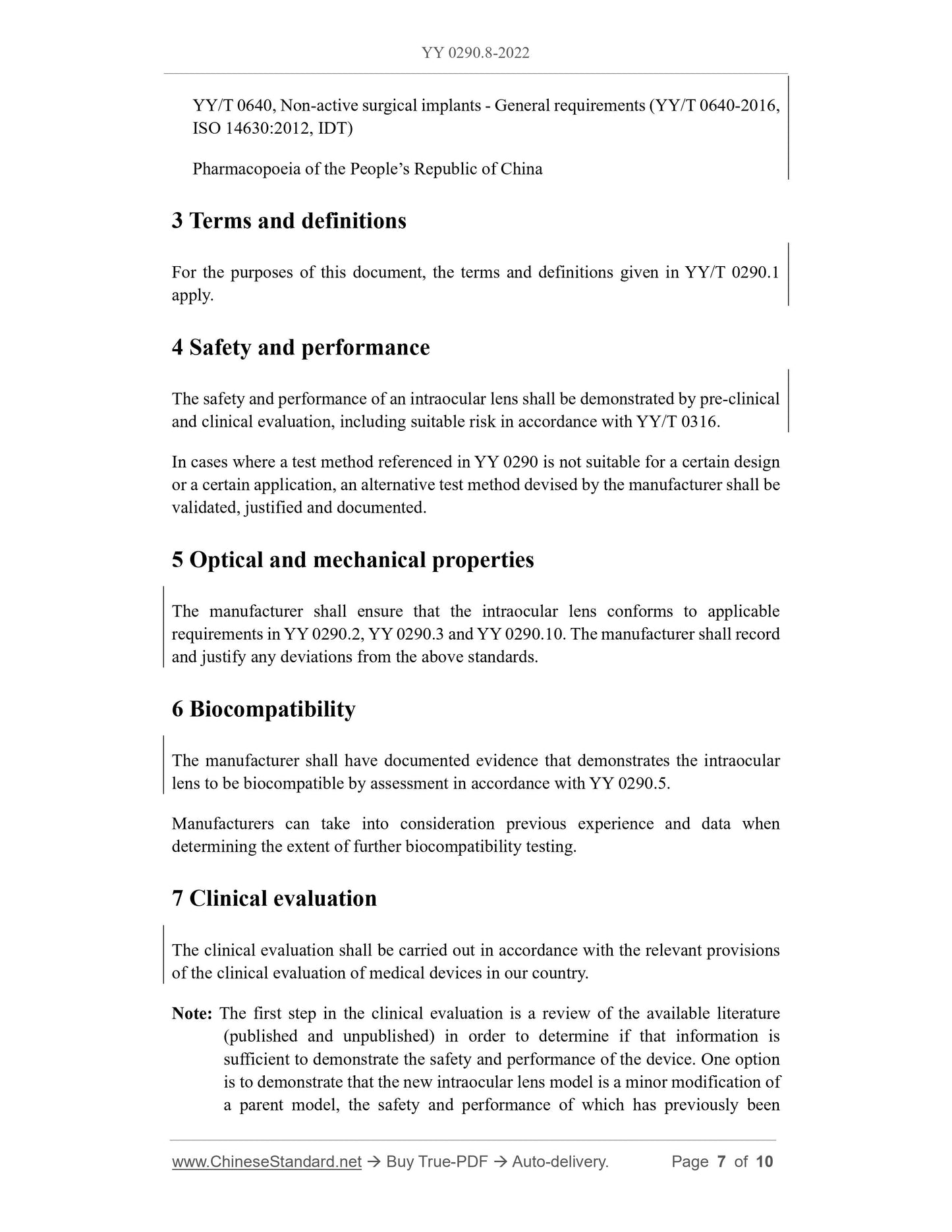NaN
/
of
-Infinity
www.ChineseStandard.us -- Field Test Asia Pte. Ltd.
YY 0290.8-2022 English PDF
YY 0290.8-2022 English PDF
Regular price
$170.00
Regular price
Sale price
$170.00
Unit price
/
per
Shipping calculated at checkout.
Couldn't load pickup availability
YY 0290.8-2022: Ophthalmic optics - Intraocular lenses - Part 8: Fundamental requirement
Delivery: 9 seconds. Download (& Email) true-PDF + Invoice.
Get Quotation: Click YY 0290.8-2022 (Self-service in 1-minute)
Historical versions (Master-website): YY 0290.8-2022
Preview True-PDF (Reload/Scroll-down if blank)
YY 0290.8-2022
YY
PHARMACEUTICAL INDUSTRY STANDARD
OF THE PEOPLE’S REPUBLIC OF CHINA
ICS 11.040
CCS C 40
Replacing YY 0290.8-2008
Ophthalmic optics - Intraocular lenses - Part 8:
Fundamental requirement
(ISO 11979-8:2017, Ophthalmic implants - Intraocular lenses - Part 8:
Fundamental requirement, MOD)
ISSUED ON: OCTOBER 17, 2022
IMPLEMENTED ON: NOVEMBER 01, 2025
Issued by: National Medical Products Administration
Table of Contents
Foreword ... 3
1 Scope ... 6
2 Normative references ... 6
3 Terms and definitions ... 7
4 Safety and performance ... 7
5 Optical and mechanical properties ... 7
6 Biocompatibility ... 7
7 Clinical evaluation ... 7
8 Manufacturing ... 8
9 Sterilization ... 8
10 Packaging and shelf-life ... 9
11 Labeling and information ... 9
12 Documentation ... 9
References ... 10
Foreword
This document was drafted in accordance with the rules provided in GB/T 1.1-2020
Directives for standardization - Part 1: Rules for the structure and drafting of
standardizing documents.
This document is part 8 of YY(/T) 0290 Ophthalmic optics - Intraocular lenses. The
following parts have been issued for YY(/T) 0290:
-- Part 1: Terminology;
-- Part 2: Optical properties and test methods;
-- Part 3: Mechanical properties and test methods;
-- Part 4: Labeling and information;
-- Part 5: Biocompatibility;
-- Part 6: Shelf-life and transport stability;
-- Part 8: Fundamental requirement;
-- Part 9: Multifocal intraocular lenses;
-- Part 10: Phakic intraocular lenses.
This document serves as a replacement of YY 0290.8-2008 Ophthalmic implants -
Intraocular lenses - Part 8: Fundamental requirement. In comparison with YY 0290.8-
2008, apart from structural adjustments and editorial modifications, the main technical
changes are as follows:
-- Modify “Normative references” (see Chapter 2; Chapter 2 of the 2008 edition);
-- Modify “Safety and performance” (see Chapter 4; Chapter 4 of the 2008 edition);
-- Modify “Optical and mechanical properties” (see Chapter 5; Chapter 5 of the 2008
edition);
-- Modify “Biocompatibility” (see Chapter 6; Chapter 6 of the 2008 edition);
-- Modify “Clinical evaluation” (see Chapter 7; Chapter 7 of the 2008 edition);
-- Modify “General requirements” (see 9.1; 9.1 of the 2008 edition);
-- Modify “Bacterial endotoxins” (see 9.2; 9.2 of the 2008 edition).
Ophthalmic optics - Intraocular lenses - Part 8:
Fundamental requirement
1 Scope
This document specifies fundamental requirements for all types of intraocular lenses
intended for surgical implantation into the anterior segment of the human eye.
This document does not apply to corneal implants and transplants.
2 Normative references
The following documents are referred to in the text in such a way that some or all of
their content constitutes requirements of this document. For dated references, only the
version corresponding to that date is applicable to this document; for undated references,
the latest version (including all amendments) is applicable to this document.
YY/T 0287, Medical devices - Quality management systems - Requirements for
regulatory purposes (YY/T 0287-2017, ISO 13485:2016, IDT)
YY/T 0290.1, Ophthalmic optics - Intraocular lenses - Part 1: Terminology (YY/T
0290.1-2021, ISO 11979-1:2018, MOD)
YY 0290.2, Ophthalmic optics - Intraocular lenses - Part 2: Optical properties and
test methods (YY 0290.2-2021, ISO 11979-2:2014, MOD)
YY 0290.3, Ophthalmic optics - Intraocular lenses - Part 3: Mechanical properties
and test methods (YY 0290.3-2018, ISO 11979-3:2012, MOD)
YY/T 0290.4, Ophthalmic optics - Intraocular lenses - Part 4: Labeling and
information (YY/T 0290.4-2008, ISO 11979-4:2000, IDT)
YY 0290.5, Ophthalmic implants - Intraocular lenses - Part 5: Biocompatibility (YY
0290.5-2008, ISO 11979-5:2006, MOD)
YY/T 0290.6, Ophthalmic optics - Intraocular lenses - Part 6: Shelf-life and transport
stability (YY/T 0290.6-2021, ISO 11979-6:2014, MOD)
YY 0290.10, Intraocular lenses - Part 10: Phakic intraocular lenses (YY 0290.10-
2009, ISO 11979-10:2006, MOD)
YY/T 0316, Medical devices - Application of risk management to medical devices
(YY/T 0316-2016, ISO 14971:2007, rectified, IDT)
YY/T 0640, Non-active surgical implants - General requirements (YY/T 0640-2016,
ISO 14630:2012, IDT)
Pharmacopoeia of the People’s Republic of China
3 Terms and definitions
For the purposes of this document, the terms and definitions given in YY/T 0290.1
apply.
4 Safety and performance
The safety and performance of an intraocular lens shall be demonstrated by pre-clinical
and clinical evaluation, including suitable risk in accordance with YY/T 0316.
In cases where a test method referenced in YY 0290 is not suitable for a certain design
or a certain application, an alternative test method devised by the manufacturer shall be
validated, justified and documented.
5 Optical and mechanical properties
The manufacturer shall ensure that the intraocular lens conforms to applicable
requirements in YY 0290.2, YY 0290.3 and YY 0290.10. The manufacturer shall record
and justify any deviations from the above standards.
6 Biocompatibility
The manufacturer shall have documented evidence that demonstrates the intraocular
lens to be biocompatible by assessment in accordance with YY 0290.5.
Manufacturers can take into consideration previous experience and data when
determining the extent of further biocompatibility testing.
7 Clinical evaluation
The clinical evaluation shall be carried out in accordance with the relevant provisions
of the clinical evaluation of medical devices in our country.
Note: The first step in the clinical evaluation is a review of the available literature
(published and unpublished) in order to determine if that information is
sufficient to demonstrate the safety and performance of the device. One option
is to demonstrate that the new intraocular lens model is a minor modification of
a parent model, the safety and performance of which has previously been
YY 0290.8-2022
YY
PHARMACEUTICAL INDUSTRY STANDARD
OF THE PEOPLE’S REPUBLIC OF CHINA
ICS 11.040
CCS C 40
Replacing YY 0290.8-2008
Ophthalmic optics - Intraocular lenses - Part 8:
Fundamental requirement
(ISO 11979-8:2017, Ophthalmic implants - Intraocular lenses - Part 8:
Fundamental requirement, MOD)
ISSUED ON: OCTOBER 17, 2022
IMPLEMENTED ON: NOVEMBER 01, 2025
Issued by: National Medical Products Administration
Table of Contents
Foreword ... 3
1 Scope ... 6
2 Normative references ... 6
3 Terms and definitions ... 7
4 Safety and performance ... 7
5 Optical and mechanical properties ... 7
6 Biocompatibility ... 7
7 Clinical evaluation ... 7
8 Manufacturing ... 8
9 Sterilization ... 8
10 Packaging and shelf-life ... 9
11 Labeling and information ... 9
12 Documentation ... 9
References ... 10
Foreword
This document was drafted in accordance with the rules provided in GB/T 1.1-2020
Directives for standardization - Part 1: Rules for the structure and drafting of
standardizing documents.
This document is part 8 of YY(/T) 0290 Ophthalmic optics - Intraocular lenses. The
following parts have been issued for YY(/T) 0290:
-- Part 1: Terminology;
-- Part 2: Optical properties and test methods;
-- Part 3: Mechanical properties and test methods;
-- Part 4: Labeling and information;
-- Part 5: Biocompatibility;
-- Part 6: Shelf-life and transport stability;
-- Part 8: Fundamental requirement;
-- Part 9: Multifocal intraocular lenses;
-- Part 10: Phakic intraocular lenses.
This document serves as a replacement of YY 0290.8-2008 Ophthalmic implants -
Intraocular lenses - Part 8: Fundamental requirement. In comparison with YY 0290.8-
2008, apart from structural adjustments and editorial modifications, the main technical
changes are as follows:
-- Modify “Normative references” (see Chapter 2; Chapter 2 of the 2008 edition);
-- Modify “Safety and performance” (see Chapter 4; Chapter 4 of the 2008 edition);
-- Modify “Optical and mechanical properties” (see Chapter 5; Chapter 5 of the 2008
edition);
-- Modify “Biocompatibility” (see Chapter 6; Chapter 6 of the 2008 edition);
-- Modify “Clinical evaluation” (see Chapter 7; Chapter 7 of the 2008 edition);
-- Modify “General requirements” (see 9.1; 9.1 of the 2008 edition);
-- Modify “Bacterial endotoxins” (see 9.2; 9.2 of the 2008 edition).
Ophthalmic optics - Intraocular lenses - Part 8:
Fundamental requirement
1 Scope
This document specifies fundamental requirements for all types of intraocular lenses
intended for surgical implantation into the anterior segment of the human eye.
This document does not apply to corneal implants and transplants.
2 Normative references
The following documents are referred to in the text in such a way that some or all of
their content constitutes requirements of this document. For dated references, only the
version corresponding to that date is applicable to this document; for undated references,
the latest version (including all amendments) is applicable to this document.
YY/T 0287, Medical devices - Quality management systems - Requirements for
regulatory purposes (YY/T 0287-2017, ISO 13485:2016, IDT)
YY/T 0290.1, Ophthalmic optics - Intraocular lenses - Part 1: Terminology (YY/T
0290.1-2021, ISO 11979-1:2018, MOD)
YY 0290.2, Ophthalmic optics - Intraocular lenses - Part 2: Optical properties and
test methods (YY 0290.2-2021, ISO 11979-2:2014, MOD)
YY 0290.3, Ophthalmic optics - Intraocular lenses - Part 3: Mechanical properties
and test methods (YY 0290.3-2018, ISO 11979-3:2012, MOD)
YY/T 0290.4, Ophthalmic optics - Intraocular lenses - Part 4: Labeling and
information (YY/T 0290.4-2008, ISO 11979-4:2000, IDT)
YY 0290.5, Ophthalmic implants - Intraocular lenses - Part 5: Biocompatibility (YY
0290.5-2008, ISO 11979-5:2006, MOD)
YY/T 0290.6, Ophthalmic optics - Intraocular lenses - Part 6: Shelf-life and transport
stability (YY/T 0290.6-2021, ISO 11979-6:2014, MOD)
YY 0290.10, Intraocular lenses - Part 10: Phakic intraocular lenses (YY 0290.10-
2009, ISO 11979-10:2006, MOD)
YY/T 0316, Medical devices - Application of risk management to medical devices
(YY/T 0316-2016, ISO 14971:2007, rectified, IDT)
YY/T 0640, Non-active surgical implants - General requirements (YY/T 0640-2016,
ISO 14630:2012, IDT)
Pharmacopoeia of the People’s Republic of China
3 Terms and definitions
For the purposes of this document, the terms and definitions given in YY/T 0290.1
apply.
4 Safety and performance
The safety and performance of an intraocular lens shall be demonstrated by pre-clinical
and clinical evaluation, including suitable risk in accordance with YY/T 0316.
In cases where a test method referenced in YY 0290 is not suitable for a certain design
or a certain application, an alternative test method devised by the manufacturer shall be
validated, justified and documented.
5 Optical and mechanical properties
The manufacturer shall ensure that the intraocular lens conforms to applicable
requirements in YY 0290.2, YY 0290.3 and YY 0290.10. The manufacturer shall record
and justify any deviations from the above standards.
6 Biocompatibility
The manufacturer shall have documented evidence that demonstrates the intraocular
lens to be biocompatible by assessment in accordance with YY 0290.5.
Manufacturers can take into consideration previous experience and data when
determining the extent of further biocompatibility testing.
7 Clinical evaluation
The clinical evaluation shall be carried out in accordance with the relevant provisions
of the clinical evaluation of medical devices in our country.
Note: The first step in the clinical evaluation is a review of the available literature
(published and unpublished) in order to determine if that information is
sufficient to demonstrate the safety and performance of the device. One option
is to demonstrate that the new intraocular lens model is a minor modification of
a parent model, the safety and performance of which has previously been
Delivery: 9 seconds. Download (& Email) true-PDF + Invoice.
Get Quotation: Click YY 0290.8-2022 (Self-service in 1-minute)
Historical versions (Master-website): YY 0290.8-2022
Preview True-PDF (Reload/Scroll-down if blank)
YY 0290.8-2022
YY
PHARMACEUTICAL INDUSTRY STANDARD
OF THE PEOPLE’S REPUBLIC OF CHINA
ICS 11.040
CCS C 40
Replacing YY 0290.8-2008
Ophthalmic optics - Intraocular lenses - Part 8:
Fundamental requirement
(ISO 11979-8:2017, Ophthalmic implants - Intraocular lenses - Part 8:
Fundamental requirement, MOD)
ISSUED ON: OCTOBER 17, 2022
IMPLEMENTED ON: NOVEMBER 01, 2025
Issued by: National Medical Products Administration
Table of Contents
Foreword ... 3
1 Scope ... 6
2 Normative references ... 6
3 Terms and definitions ... 7
4 Safety and performance ... 7
5 Optical and mechanical properties ... 7
6 Biocompatibility ... 7
7 Clinical evaluation ... 7
8 Manufacturing ... 8
9 Sterilization ... 8
10 Packaging and shelf-life ... 9
11 Labeling and information ... 9
12 Documentation ... 9
References ... 10
Foreword
This document was drafted in accordance with the rules provided in GB/T 1.1-2020
Directives for standardization - Part 1: Rules for the structure and drafting of
standardizing documents.
This document is part 8 of YY(/T) 0290 Ophthalmic optics - Intraocular lenses. The
following parts have been issued for YY(/T) 0290:
-- Part 1: Terminology;
-- Part 2: Optical properties and test methods;
-- Part 3: Mechanical properties and test methods;
-- Part 4: Labeling and information;
-- Part 5: Biocompatibility;
-- Part 6: Shelf-life and transport stability;
-- Part 8: Fundamental requirement;
-- Part 9: Multifocal intraocular lenses;
-- Part 10: Phakic intraocular lenses.
This document serves as a replacement of YY 0290.8-2008 Ophthalmic implants -
Intraocular lenses - Part 8: Fundamental requirement. In comparison with YY 0290.8-
2008, apart from structural adjustments and editorial modifications, the main technical
changes are as follows:
-- Modify “Normative references” (see Chapter 2; Chapter 2 of the 2008 edition);
-- Modify “Safety and performance” (see Chapter 4; Chapter 4 of the 2008 edition);
-- Modify “Optical and mechanical properties” (see Chapter 5; Chapter 5 of the 2008
edition);
-- Modify “Biocompatibility” (see Chapter 6; Chapter 6 of the 2008 edition);
-- Modify “Clinical evaluation” (see Chapter 7; Chapter 7 of the 2008 edition);
-- Modify “General requirements” (see 9.1; 9.1 of the 2008 edition);
-- Modify “Bacterial endotoxins” (see 9.2; 9.2 of the 2008 edition).
Ophthalmic optics - Intraocular lenses - Part 8:
Fundamental requirement
1 Scope
This document specifies fundamental requirements for all types of intraocular lenses
intended for surgical implantation into the anterior segment of the human eye.
This document does not apply to corneal implants and transplants.
2 Normative references
The following documents are referred to in the text in such a way that some or all of
their content constitutes requirements of this document. For dated references, only the
version corresponding to that date is applicable to this document; for undated references,
the latest version (including all amendments) is applicable to this document.
YY/T 0287, Medical devices - Quality management systems - Requirements for
regulatory purposes (YY/T 0287-2017, ISO 13485:2016, IDT)
YY/T 0290.1, Ophthalmic optics - Intraocular lenses - Part 1: Terminology (YY/T
0290.1-2021, ISO 11979-1:2018, MOD)
YY 0290.2, Ophthalmic optics - Intraocular lenses - Part 2: Optical properties and
test methods (YY 0290.2-2021, ISO 11979-2:2014, MOD)
YY 0290.3, Ophthalmic optics - Intraocular lenses - Part 3: Mechanical properties
and test methods (YY 0290.3-2018, ISO 11979-3:2012, MOD)
YY/T 0290.4, Ophthalmic optics - Intraocular lenses - Part 4: Labeling and
information (YY/T 0290.4-2008, ISO 11979-4:2000, IDT)
YY 0290.5, Ophthalmic implants - Intraocular lenses - Part 5: Biocompatibility (YY
0290.5-2008, ISO 11979-5:2006, MOD)
YY/T 0290.6, Ophthalmic optics - Intraocular lenses - Part 6: Shelf-life and transport
stability (YY/T 0290.6-2021, ISO 11979-6:2014, MOD)
YY 0290.10, Intraocular lenses - Part 10: Phakic intraocular lenses (YY 0290.10-
2009, ISO 11979-10:2006, MOD)
YY/T 0316, Medical devices - Application of risk management to medical devices
(YY/T 0316-2016, ISO 14971:2007, rectified, IDT)
YY/T 0640, Non-active surgical implants - General requirements (YY/T 0640-2016,
ISO 14630:2012, IDT)
Pharmacopoeia of the People’s Republic of China
3 Terms and definitions
For the purposes of this document, the terms and definitions given in YY/T 0290.1
apply.
4 Safety and performance
The safety and performance of an intraocular lens shall be demonstrated by pre-clinical
and clinical evaluation, including suitable risk in accordance with YY/T 0316.
In cases where a test method referenced in YY 0290 is not suitable for a certain design
or a certain application, an alternative test method devised by the manufacturer shall be
validated, justified and documented.
5 Optical and mechanical properties
The manufacturer shall ensure that the intraocular lens conforms to applicable
requirements in YY 0290.2, YY 0290.3 and YY 0290.10. The manufacturer shall record
and justify any deviations from the above standards.
6 Biocompatibility
The manufacturer shall have documented evidence that demonstrates the intraocular
lens to be biocompatible by assessment in accordance with YY 0290.5.
Manufacturers can take into consideration previous experience and data when
determining the extent of further biocompatibility testing.
7 Clinical evaluation
The clinical evaluation shall be carried out in accordance with the relevant provisions
of the clinical evaluation of medical devices in our country.
Note: The first step in the clinical evaluation is a review of the available literature
(published and unpublished) in order to determine if that information is
sufficient to demonstrate the safety and performance of the device. One option
is to demonstrate that the new intraocular lens model is a minor modification of
a parent model, the safety and performance of which has previously been
YY 0290.8-2022
YY
PHARMACEUTICAL INDUSTRY STANDARD
OF THE PEOPLE’S REPUBLIC OF CHINA
ICS 11.040
CCS C 40
Replacing YY 0290.8-2008
Ophthalmic optics - Intraocular lenses - Part 8:
Fundamental requirement
(ISO 11979-8:2017, Ophthalmic implants - Intraocular lenses - Part 8:
Fundamental requirement, MOD)
ISSUED ON: OCTOBER 17, 2022
IMPLEMENTED ON: NOVEMBER 01, 2025
Issued by: National Medical Products Administration
Table of Contents
Foreword ... 3
1 Scope ... 6
2 Normative references ... 6
3 Terms and definitions ... 7
4 Safety and performance ... 7
5 Optical and mechanical properties ... 7
6 Biocompatibility ... 7
7 Clinical evaluation ... 7
8 Manufacturing ... 8
9 Sterilization ... 8
10 Packaging and shelf-life ... 9
11 Labeling and information ... 9
12 Documentation ... 9
References ... 10
Foreword
This document was drafted in accordance with the rules provided in GB/T 1.1-2020
Directives for standardization - Part 1: Rules for the structure and drafting of
standardizing documents.
This document is part 8 of YY(/T) 0290 Ophthalmic optics - Intraocular lenses. The
following parts have been issued for YY(/T) 0290:
-- Part 1: Terminology;
-- Part 2: Optical properties and test methods;
-- Part 3: Mechanical properties and test methods;
-- Part 4: Labeling and information;
-- Part 5: Biocompatibility;
-- Part 6: Shelf-life and transport stability;
-- Part 8: Fundamental requirement;
-- Part 9: Multifocal intraocular lenses;
-- Part 10: Phakic intraocular lenses.
This document serves as a replacement of YY 0290.8-2008 Ophthalmic implants -
Intraocular lenses - Part 8: Fundamental requirement. In comparison with YY 0290.8-
2008, apart from structural adjustments and editorial modifications, the main technical
changes are as follows:
-- Modify “Normative references” (see Chapter 2; Chapter 2 of the 2008 edition);
-- Modify “Safety and performance” (see Chapter 4; Chapter 4 of the 2008 edition);
-- Modify “Optical and mechanical properties” (see Chapter 5; Chapter 5 of the 2008
edition);
-- Modify “Biocompatibility” (see Chapter 6; Chapter 6 of the 2008 edition);
-- Modify “Clinical evaluation” (see Chapter 7; Chapter 7 of the 2008 edition);
-- Modify “General requirements” (see 9.1; 9.1 of the 2008 edition);
-- Modify “Bacterial endotoxins” (see 9.2; 9.2 of the 2008 edition).
Ophthalmic optics - Intraocular lenses - Part 8:
Fundamental requirement
1 Scope
This document specifies fundamental requirements for all types of intraocular lenses
intended for surgical implantation into the anterior segment of the human eye.
This document does not apply to corneal implants and transplants.
2 Normative references
The following documents are referred to in the text in such a way that some or all of
their content constitutes requirements of this document. For dated references, only the
version corresponding to that date is applicable to this document; for undated references,
the latest version (including all amendments) is applicable to this document.
YY/T 0287, Medical devices - Quality management systems - Requirements for
regulatory purposes (YY/T 0287-2017, ISO 13485:2016, IDT)
YY/T 0290.1, Ophthalmic optics - Intraocular lenses - Part 1: Terminology (YY/T
0290.1-2021, ISO 11979-1:2018, MOD)
YY 0290.2, Ophthalmic optics - Intraocular lenses - Part 2: Optical properties and
test methods (YY 0290.2-2021, ISO 11979-2:2014, MOD)
YY 0290.3, Ophthalmic optics - Intraocular lenses - Part 3: Mechanical properties
and test methods (YY 0290.3-2018, ISO 11979-3:2012, MOD)
YY/T 0290.4, Ophthalmic optics - Intraocular lenses - Part 4: Labeling and
information (YY/T 0290.4-2008, ISO 11979-4:2000, IDT)
YY 0290.5, Ophthalmic implants - Intraocular lenses - Part 5: Biocompatibility (YY
0290.5-2008, ISO 11979-5:2006, MOD)
YY/T 0290.6, Ophthalmic optics - Intraocular lenses - Part 6: Shelf-life and transport
stability (YY/T 0290.6-2021, ISO 11979-6:2014, MOD)
YY 0290.10, Intraocular lenses - Part 10: Phakic intraocular lenses (YY 0290.10-
2009, ISO 11979-10:2006, MOD)
YY/T 0316, Medical devices - Application of risk management to medical devices
(YY/T 0316-2016, ISO 14971:2007, rectified, IDT)
YY/T 0640, Non-active surgical implants - General requirements (YY/T 0640-2016,
ISO 14630:2012, IDT)
Pharmacopoeia of the People’s Republic of China
3 Terms and definitions
For the purposes of this document, the terms and definitions given in YY/T 0290.1
apply.
4 Safety and performance
The safety and performance of an intraocular lens shall be demonstrated by pre-clinical
and clinical evaluation, including suitable risk in accordance with YY/T 0316.
In cases where a test method referenced in YY 0290 is not suitable for a certain design
or a certain application, an alternative test method devised by the manufacturer shall be
validated, justified and documented.
5 Optical and mechanical properties
The manufacturer shall ensure that the intraocular lens conforms to applicable
requirements in YY 0290.2, YY 0290.3 and YY 0290.10. The manufacturer shall record
and justify any deviations from the above standards.
6 Biocompatibility
The manufacturer shall have documented evidence that demonstrates the intraocular
lens to be biocompatible by assessment in accordance with YY 0290.5.
Manufacturers can take into consideration previous experience and data when
determining the extent of further biocompatibility testing.
7 Clinical evaluation
The clinical evaluation shall be carried out in accordance with the relevant provisions
of the clinical evaluation of medical devices in our country.
Note: The first step in the clinical evaluation is a review of the available literature
(published and unpublished) in order to determine if that information is
sufficient to demonstrate the safety and performance of the device. One option
is to demonstrate that the new intraocular lens model is a minor modification of
a parent model, the safety and performance of which has previously been





